Abstract
1. The present study was undertaken to ascertain whether 5-hydroxytryptamine (5-HT) acting at either 5-HT3 or 5-HT4 receptors plays a significant role in motility reflexes in the guinea-pig small intestine. 2. An isolated segment of small intestine was opened along its mesenteric border and pinned, mucosa uppermost, in a three chambered organ bath so that the oral, middle and anal regions of a single preparation could be separately superfused. 3. Conventional intracellular recording methods were used to monitor the responses of the circular muscle in the oral or the anal end chambers when distension was applied in either of the other two chambers or the mucosal villi were compressed in the middle chamber. Drugs were added to the middle chamber. 4. 5-HT3 receptor antagonists (tropisetron, 0.1-10 microM; granisetron, 1 microM and BRL 46470, 1 microM) depressed the ascending excitatory reflex evoked by these stimuli but had no effect on the descending inhibitory reflex. The depression of the excitatory reflex was observed whether the reflex was evoked from the chamber containing the drug or was simply conducted, via interneurones, through this chamber. 5. The 5-HT4 receptor antagonist, SDZ 205-557 (1 microM), had no significant effect on either the ascending or descending reflex pathways. However, 5-HT4 receptors were present as cisapride (0.1 microM) significantly enhanced the ascending excitation without affecting the descending inhibition. This effect of cisapride was converted to a significant depression of the ascending reflex by SDZ 205-557.(ABSTRACT TRUNCATED AT 250 WORDS)
Full text
PDF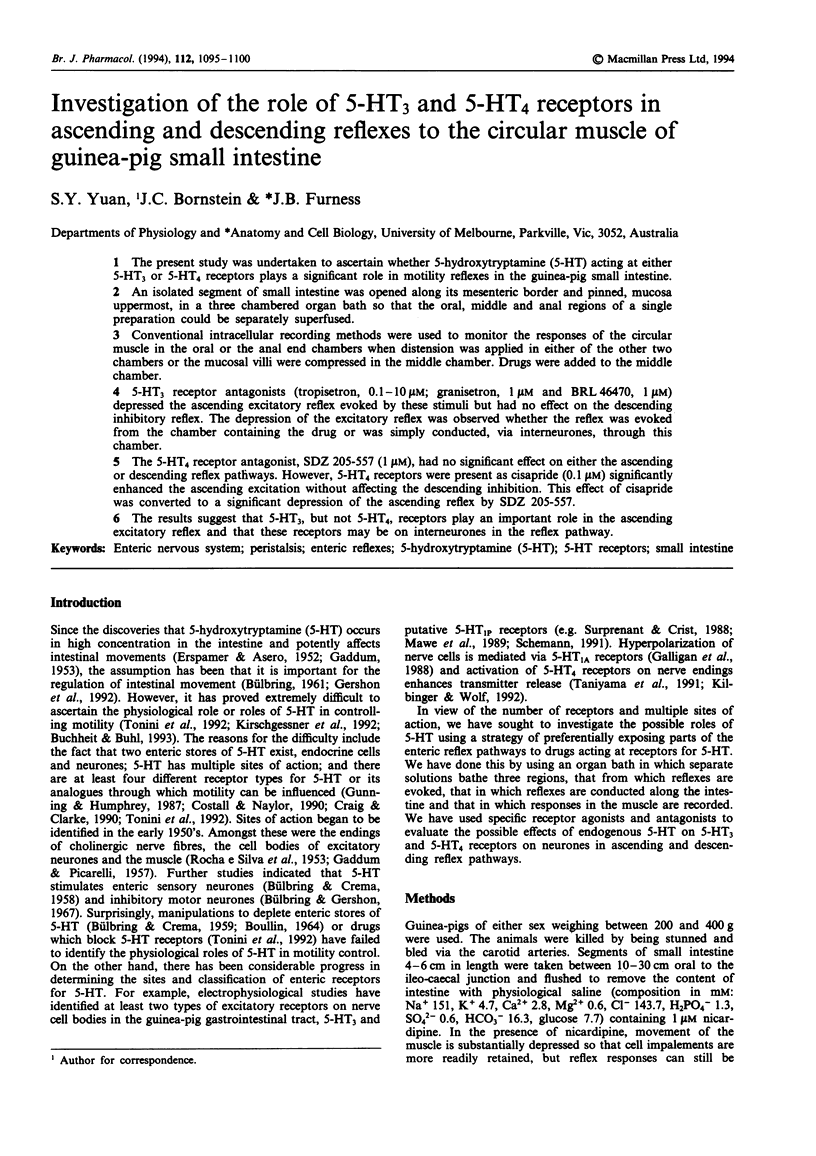
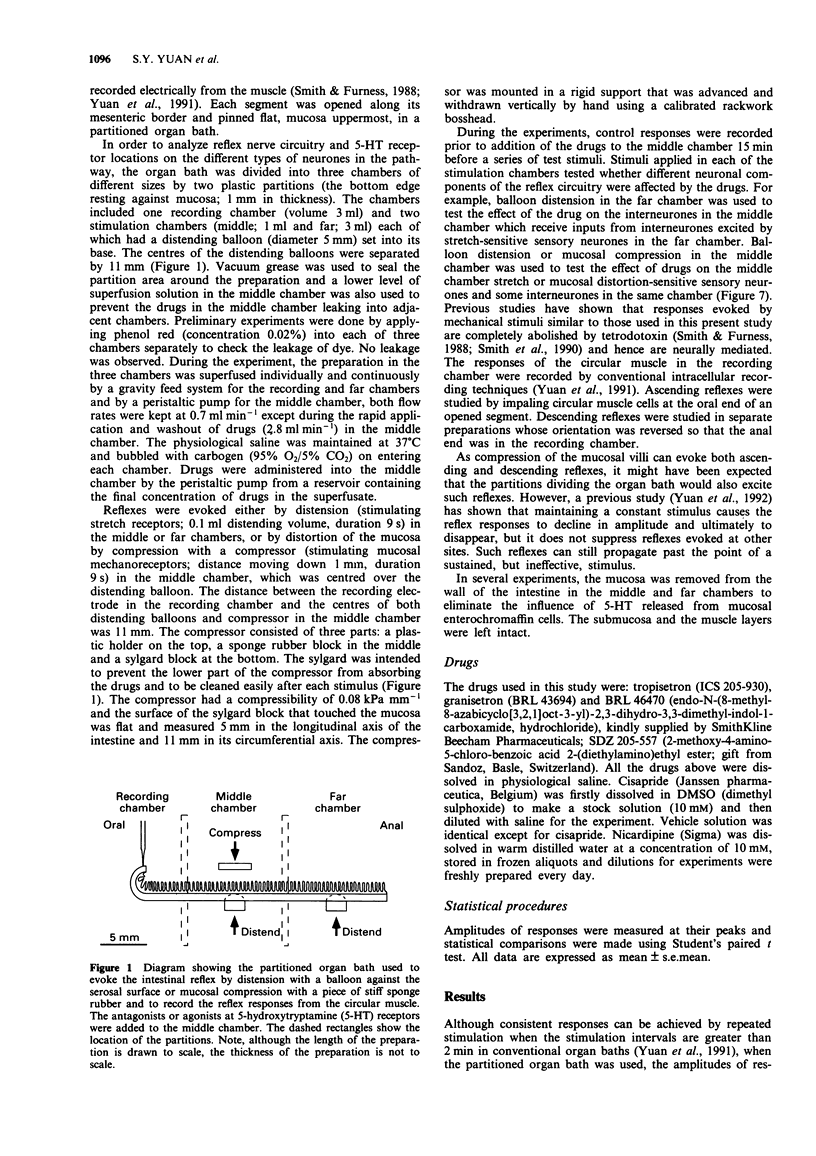
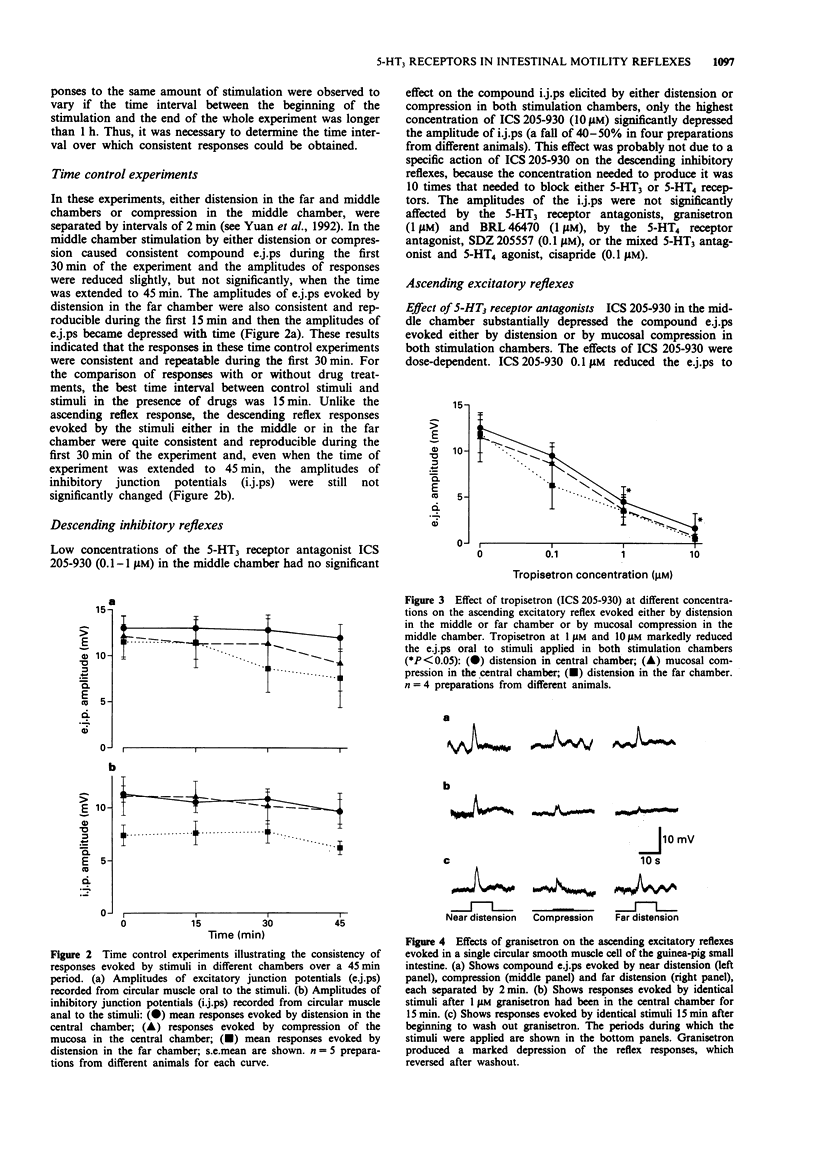
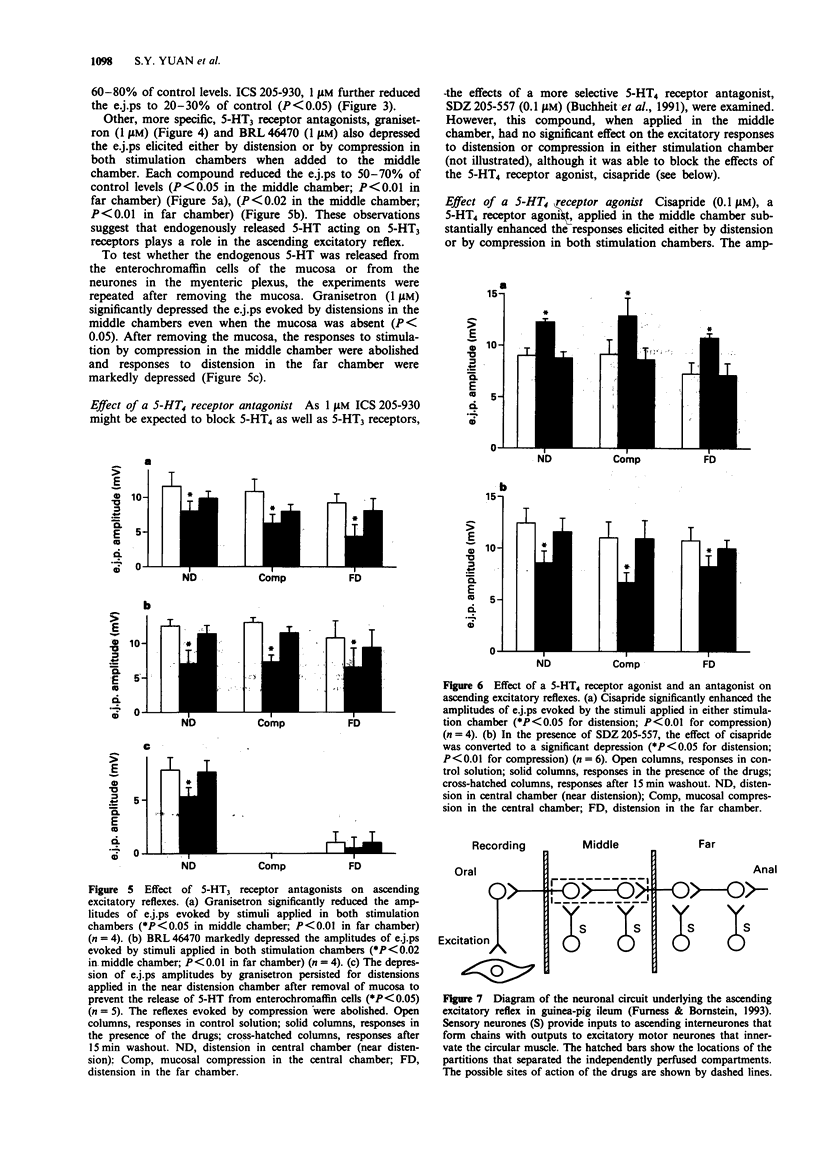
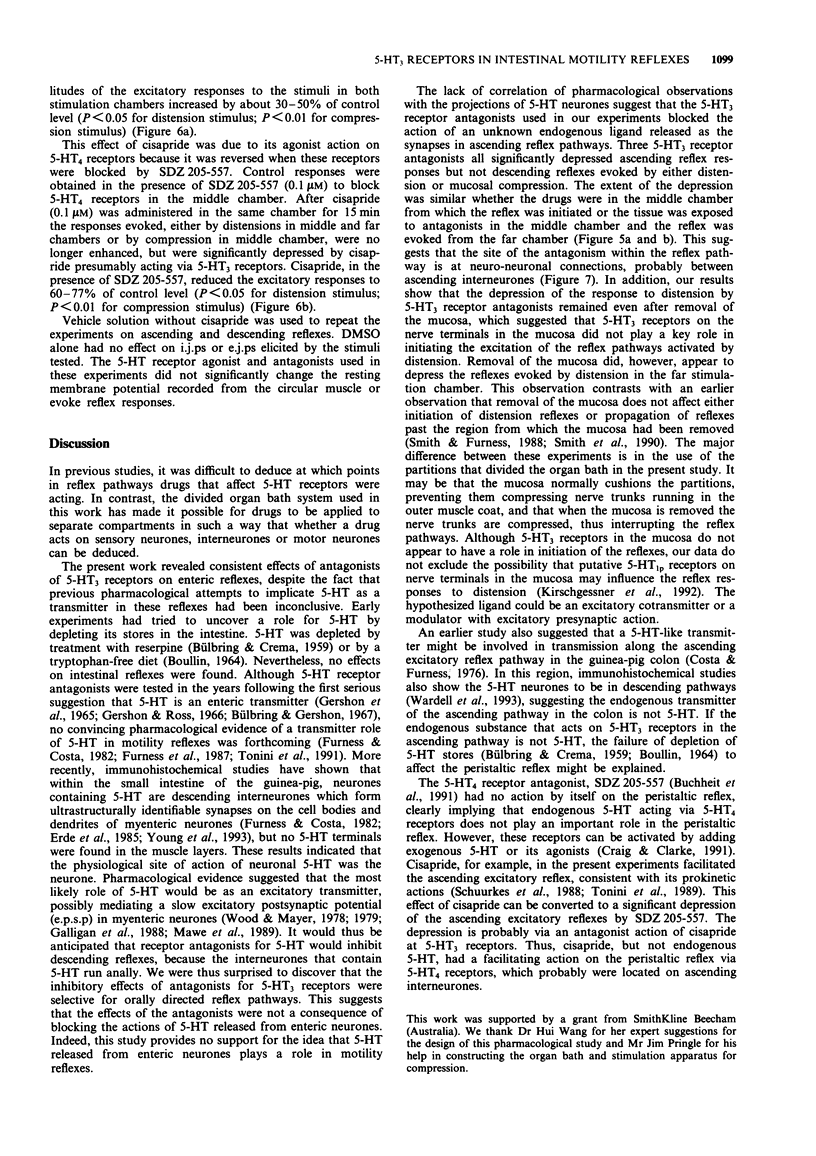
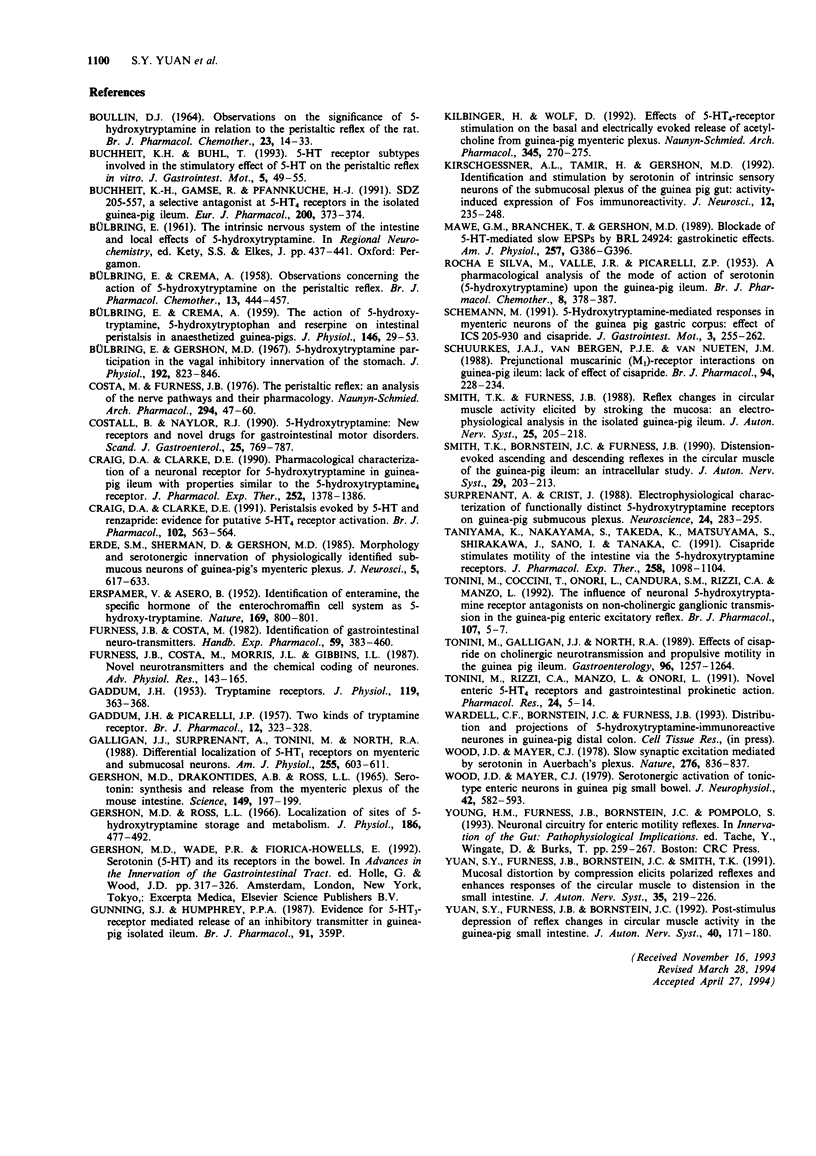
Selected References
These references are in PubMed. This may not be the complete list of references from this article.
- BOULLIN D. J. OBSERVATIONS ON THE SIGNIFICANCE OF 5-HYDROXYTRYPTAMINE IN RELATION TO THE PERISTALTIC REFLEX OF THE RAT. Br J Pharmacol Chemother. 1964 Aug;23:14–33. doi: 10.1111/j.1476-5381.1964.tb01563.x. [DOI] [PMC free article] [PubMed] [Google Scholar]
- BULBRING E., CREMA A. Observations concerning the action of 5-hydroxytryptamine on the peristaltic reflex. Br J Pharmacol Chemother. 1958 Dec;13(4):444–457. doi: 10.1111/j.1476-5381.1958.tb00236.x. [DOI] [PMC free article] [PubMed] [Google Scholar]
- BULBRING E., CREMA A. The action of 5-hydroxytryptamine, 5-hydroxytryptophan and reserpine on intestinal peristalsis in anaesthetized guinea-pigs. J Physiol. 1959 Apr 23;146(1):29–53. doi: 10.1113/jphysiol.1959.sp006176. [DOI] [PMC free article] [PubMed] [Google Scholar]
- Buchheit K. H., Gamse R., Pfannkuche H. J. SDZ 205-557, a selective antagonist at 5-HT4 receptors in the isolated guinea pig ileum. Eur J Pharmacol. 1991 Aug 6;200(2-3):373–374. doi: 10.1016/0014-2999(91)90601-l. [DOI] [PubMed] [Google Scholar]
- Bülbring E., Gershon M. D. 5-hydroxytryptamine participation in the vagal inhibitory innervation of the stomach. J Physiol. 1967 Oct;192(3):823–846. doi: 10.1113/jphysiol.1967.sp008334. [DOI] [PMC free article] [PubMed] [Google Scholar]
- Costa M., Furness J. B. The peristaltic reflex: an analysis of the nerve pathways and their pharmacology. Naunyn Schmiedebergs Arch Pharmacol. 1976 Jul;294(1):47–60. doi: 10.1007/BF00692784. [DOI] [PubMed] [Google Scholar]
- Costall B., Naylor R. J. 5-Hydroxytryptamine: new receptors and novel drugs for gastrointestinal motor disorders. Scand J Gastroenterol. 1990 Aug;25(8):769–787. doi: 10.3109/00365529008999215. [DOI] [PubMed] [Google Scholar]
- Craig D. A., Clarke D. E. Peristalsis evoked by 5-HT and renzapride: evidence for putative 5-HT4 receptor activation. Br J Pharmacol. 1991 Mar;102(3):563–564. doi: 10.1111/j.1476-5381.1991.tb12211.x. [DOI] [PMC free article] [PubMed] [Google Scholar]
- Craig D. A., Clarke D. E. Pharmacological characterization of a neuronal receptor for 5-hydroxytryptamine in guinea pig ileum with properties similar to the 5-hydroxytryptamine receptor. J Pharmacol Exp Ther. 1990 Mar;252(3):1378–1386. [PubMed] [Google Scholar]
- ERSPAMER V., ASERO B. Identification of enteramine, the specific hormone of the enterochromaffin cell system, as 5-hydroxytryptamine. Nature. 1952 May 10;169(4306):800–801. doi: 10.1038/169800b0. [DOI] [PubMed] [Google Scholar]
- Erde S. M., Sherman D., Gershon M. D. Morphology and serotonergic innervation of physiologically identified cells of the guinea pig's myenteric plexus. J Neurosci. 1985 Mar;5(3):617–633. doi: 10.1523/JNEUROSCI.05-03-00617.1985. [DOI] [PMC free article] [PubMed] [Google Scholar]
- GADDUM J. H., PICARELLI Z. P. Two kinds of tryptamine receptor. Br J Pharmacol Chemother. 1957 Sep;12(3):323–328. doi: 10.1111/j.1476-5381.1957.tb00142.x. [DOI] [PMC free article] [PubMed] [Google Scholar]
- GADDUM J. H. Tryptamine receptors. J Physiol. 1953 Feb 27;119(2-3):363–368. doi: 10.1113/jphysiol.1953.sp004851. [DOI] [PMC free article] [PubMed] [Google Scholar]
- GERSHON M. D., DRAKONTIDES A. B., ROSS L. L. SEROTONIN: SYNTHESIS AND RELEASE FROM THE MYENTERIC PLEXUS OF THE MOUSE INTESTINE. Science. 1965 Jul 9;149(3680):197–199. doi: 10.1126/science.149.3680.197. [DOI] [PubMed] [Google Scholar]
- Gershon M. D., Ross L. L. Location of sites of 5-hydroxytryptamine storage and metabolism by radioautography. J Physiol. 1966 Oct;186(2):477–492. doi: 10.1113/jphysiol.1966.sp008047. [DOI] [PMC free article] [PubMed] [Google Scholar]
- Kilbinger H., Wolf D. Effects of 5-HT4 receptor stimulation on basal and electrically evoked release of acetylcholine from guinea-pig myenteric plexus. Naunyn Schmiedebergs Arch Pharmacol. 1992 Mar;345(3):270–275. doi: 10.1007/BF00168686. [DOI] [PubMed] [Google Scholar]
- Kirchgessner A. L., Tamir H., Gershon M. D. Identification and stimulation by serotonin of intrinsic sensory neurons of the submucosal plexus of the guinea pig gut: activity-induced expression of Fos immunoreactivity. J Neurosci. 1992 Jan;12(1):235–248. doi: 10.1523/JNEUROSCI.12-01-00235.1992. [DOI] [PMC free article] [PubMed] [Google Scholar]
- Mawe G. M., Branchek T. A., Gershon M. D. Blockade of 5-HT-mediated enteric slow EPSPs by BRL 24924: gastrokinetic effects. Am J Physiol. 1989 Sep;257(3 Pt 1):G386–G396. doi: 10.1152/ajpgi.1989.257.3.G386. [DOI] [PubMed] [Google Scholar]
- ROCHA E SILVA M., VALLE J. R., PICARELLI P. A pharmacological analysis of the mode of action of serotonin (5-hydroxytryptamine) upon the guinea-pig ileum. Br J Pharmacol Chemother. 1953 Dec;8(4):378–388. doi: 10.1111/j.1476-5381.1953.tb01333.x. [DOI] [PMC free article] [PubMed] [Google Scholar]
- Schuurkes J. A., Van Bergen P. J., Van Nueten J. M. Prejunctional muscarinic (M1)-receptor interactions on guinea-pig ileum: lack of effect of cisapride. Br J Pharmacol. 1988 May;94(1):228–234. doi: 10.1111/j.1476-5381.1988.tb11519.x. [DOI] [PMC free article] [PubMed] [Google Scholar]
- Smith T. K., Bornstein J. C., Furness J. B. Distension-evoked ascending and descending reflexes in the circular muscle of guinea-pig ileum: an intracellular study. J Auton Nerv Syst. 1990 Mar;29(3):203–217. doi: 10.1016/0165-1838(90)90146-a. [DOI] [PubMed] [Google Scholar]
- Smith T. K., Furness J. B. Reflex changes in circular muscle activity elicited by stroking the mucosa: an electrophysiological analysis in the isolated guinea-pig ileum. J Auton Nerv Syst. 1988 Dec;25(2-3):205–218. doi: 10.1016/0165-1838(88)90025-2. [DOI] [PubMed] [Google Scholar]
- Surprenant A., Crist J. Electrophysiological characterization of functionally distinct 5-hydroxytryptamine receptors on guinea-pig submucous plexus. Neuroscience. 1988 Jan;24(1):283–295. doi: 10.1016/0306-4522(88)90331-4. [DOI] [PubMed] [Google Scholar]
- Taniyama K., Nakayama S., Takeda K., Matsuyama S., Shirakawa J., Sano I., Tanaka C. Cisapride stimulates motility of the intestine via the 5-hydroxytryptamine receptors. J Pharmacol Exp Ther. 1991 Sep;258(3):1098–1104. [PubMed] [Google Scholar]
- Tonini M., Coccini T., Onori L., Candura S. M., Rizzi C. A., Manzo L. The influence of neuronal 5-hydroxytryptamine receptor antagonists on non-cholinergic ganglionic transmission in the guinea-pig enteric excitatory reflex. Br J Pharmacol. 1992 Sep;107(1):5–7. doi: 10.1111/j.1476-5381.1992.tb14455.x. [DOI] [PMC free article] [PubMed] [Google Scholar]
- Tonini M., Galligan J. J., North R. A. Effects of cisapride on cholinergic neurotransmission and propulsive motility in the guinea pig ileum. Gastroenterology. 1989 May;96(5 Pt 1):1257–1264. doi: 10.1016/s0016-5085(89)80012-5. [DOI] [PubMed] [Google Scholar]
- Tonini M., Rizzi C. A., Manzo L., Onori L. Novel enteric 5-HT4 receptors and gastrointestinal prokinetic action. Pharmacol Res. 1991 Jul;24(1):5–14. doi: 10.1016/1043-6618(91)90059-7. [DOI] [PubMed] [Google Scholar]
- Wood J. D., Mayer C. J. Serotonergic activation of tonic-type enteric neurons in guinea pig small bowel. J Neurophysiol. 1979 Mar;42(2):582–593. doi: 10.1152/jn.1979.42.2.582. [DOI] [PubMed] [Google Scholar]
- Wood J. D., Mayer C. J. Slow synaptic excitation mediated by serotonin in Auerbach's plexus. Nature. 1978 Dec 21;276(5690):836–837. doi: 10.1038/276836a0. [DOI] [PubMed] [Google Scholar]
- Yuan S. Y., Furness J. B., Bornstein J. C. Post-stimulus depression of reflex changes in circular muscle activity in the guinea pig small intestine. J Auton Nerv Syst. 1992 Oct;40(3):171–180. doi: 10.1016/0165-1838(92)90198-p. [DOI] [PubMed] [Google Scholar]
- Yuan S. Y., Furness J. B., Bornstein J. C., Smith T. K. Mucosal distortion by compression elicits polarized reflexes and enhances responses of the circular muscle to distension in the small intestine. J Auton Nerv Syst. 1991 Sep;35(3):219–226. doi: 10.1016/0165-1838(91)90100-h. [DOI] [PubMed] [Google Scholar]


